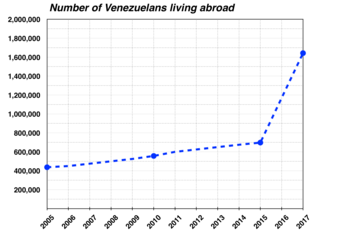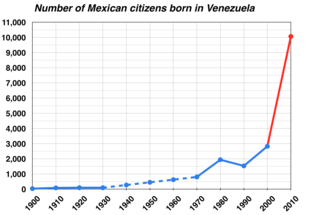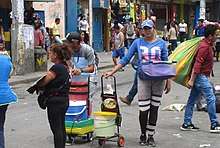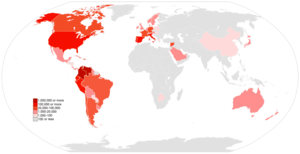Bolivarian diaspora
| Part of Crisis in Bolivarian Venezuela | |
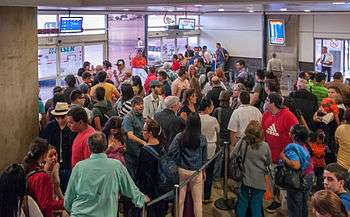 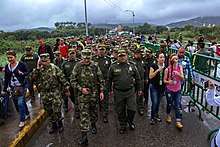  (top to bottom, left to right) Airline passengers leaving Venezuela from Maiquetia Airport; Colombian National Police leading Venezuelans into Cucuta, Colombia; refugees seeking shade in a makeshift shelter | |
| Date | 1998–present |
|---|---|
| Location | Venezuela |
| Cause | Social issues, political repression, crime, economic downturn, corruption, poverty, censorship, unemployment, shortages, undernutrition, human rights violations and others[1][2][3] |
| Outcome |
|
| Crisis in Venezuela |
|---|
 |
| Effects |
|
|
| Events |
|
|
| Elections |
|
|
| Protests |
| Timeline |
|
|
| Armed violence |
|
|
The Bolivarian diaspora, the largest recorded refugee crisis in the Americas,[7][8][9][10] refers to the emigration of millions of Venezuelans from their native country during the presidencies of Hugo Chávez and Nicolás Maduro due to the presidents' Bolivarian Revolution.[1][2][11] The revolution was an attempt by Chávez – and, later, Maduro – to establish a cultural and political hegemony[12][13][14] which culminated in the crisis in Bolivarian Venezuela when their populist policies failed.[15] The resulting refugee crisis has been compared to those faced by Cuban exiles, Syrian refugees, and those affected by European migrant crisis.[16][17] The Bolivarian government of Venezuela has denied any migratory crisis, stating that the United Nations and others are attempting to justify foreign intervention within Venezuela.[18]
Newsweek described the Bolivarian diaspora as "a reversal of fortune on a massive scale", where the "reversal" is a comparison with Venezuela's high immigration rate during the 20th century.[2] Initially, upper class Venezuelans and scholars emigrated during Chávez's presidency; middle- and lower-class Venezuelans began to leave as conditions worsened in the country.[19] This created a brain drain, due to the large number of emigrants who were educated or skilled.[20][21]
During the crisis, Venezuelans have often been asked about their desire to leave their native country;[22] over 30 percent of those asked in a December 2015 survey said that they planned to permanently leave Venezuela.[23] The percentage nearly doubled the following September; according to Datincorp, 57 percent of respondents wanted to leave the country.[24] By 2018, about four million Venezuelans – more than 10 percent of the country's population – had emigrated since the revolution began in 1999.[6][25]
History
During the 20th century, "Venezuela was a haven for immigrants fleeing Old World repression and intolerance".[2] Emigration began in 1983 after oil prices collapsed, although "the outflow, mainly of professionals, has accelerated sharply under Mr. Chávez's Bolivarian Revolution".[26] Andrés Bello Catholic University Economic and Social Research Institute head Anitza Freitez said that emigration had existed in Venezuela, but became more prominent during Chávez's presidency.[27]
First diaspora
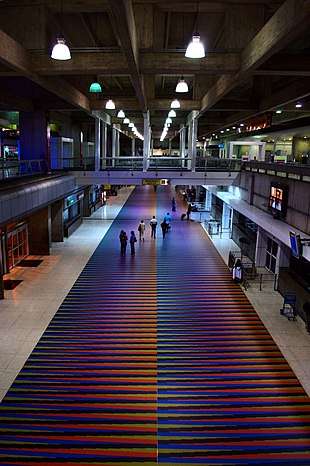
In 1998, when Chávez was first elected, 14 Venezuelans were granted asylum in the United States; according to U.S. Citizenship and Immigration Services, 1,086 Venezuelans were granted asylum in the 12-month period ending in September 1999.[30] Chávez's promise to redistribute wealth to the poor concerned wealthy and middle-class Venezuelans, triggering the first wave of emigrants fleeing the Bolivarian government.[31]
After the April 2002 Venezuelan coup d'état attempt in 2002 and years of political tension following Chávez's rise to power, Venezuela experienced a spike in emigration.[32] A May 2002 cable from the U.S. embassy in Caracas to United States agencies expressed astonishment at the number of Venezuelans attempting to enter the United States: "This drain of skilled workers could have a significant impact on Venezuela's future".[33] By June of that year, many Venezuelans who had family or links to other countries had emigrated; others, who had immigrated to Venezuela, began to leave due to economic and political instability.[32]
Following the 2006 Venezuelan presidential elections and Chávez's re-election, visits to emigration websites by Venezuelans increased; visits to MeQuieroIr.com rose from 20,000 in December 2006 to 30,000 in January 2007, and there was a 700-percent increase in visa applications from Venezuelans at vivaenaustralia.com.[34] In 2009, it was estimated that more than one million Venezuelans had emigrated since Hugo Chávez became president.[2] According to the Central University of Venezuela, an estimated 1.5 million Venezuelans (four to six percent of the country's total population) emigrated between 1999 and 2014.[20]
Second diaspora
Academics and business leaders have said that emigration from Venezuela increased significantly during the final years of Chávez's presidency and, especially, during the presidency of Nicolás Maduro.[36] This second wave consisted of lower-income Venezuelans, the people whom Chávez attempted to aid and who were experiencing hunger in the country's economic crisis.[31] Between 2012 and 2015, the number of Venezuelans who emigrated increased by 2,889 percent.[37]
In 2015, the country's business PGA Group estimated that a total of about 1.8 million Venezuelans had emigrated.[38][39] The following year, an estimated 150,000-plus Venezuelans emigrated – "the highest [number] in more than a decade, according to scholars studying the exodus".[31] Venezuelans have emigrated in a number of ways, and images of migrants fleeing by sea have been compared to Cuban exiles.[31]
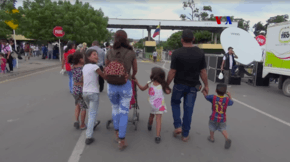
According to the Colombian government, more than 100,000 Venezuelans emigrated to Colombia in the first half of 2017.[40] In the run-up to the 2017 Venezuelan Constitutional Assembly elections, Colombia granted a Special Permit of Permanence to Venezuelan citizens who entered the country before 25 July; over 22,000 Venezuelans applied for permanent residency in Colombia in the program's first 24 hours.[41]
The United Nations High Commissioner for Refugees found that host countries throughout Latin America recorded more than one million Venezuelans settling between 2014 and 2017.[42] The intergovernmental International Organization for Migration (IOM) had similar figures, with about one million Venezuelans emigrating between 2015 and 2017 in their data;[35] other statistics indicated that the IOM's numbers may have been conservative.[43] After President Maduro's re-election in May 2018, emigration continued; Venezuelans believed that Maduro's policies would not change, and conditions in the country would continue to deteriorate.[44] In September 2018, the United Nations High Commissioner for Refugees' regional representative officially compared the crisis with the migrant and refugee crisis caused by the Syrian civil war.[17]
Causes
—Tomás Páez, Central University of Venezuela[31]
El Universal reported that according to Venezuelan Community Abroad. A New Method of Exile, a Central University of Venezuela study, the Bolivarian diaspora has been caused by the "deterioration of both the economy and the social fabric, rampant crime, uncertainty and lack of hope for a change in leadership in the near future".[1] The Wall Street Journal said that many "white-collar Venezuelans have fled the country's high crime rates, soaring inflation and expanding statist controls".[26] Studies of current and former citizens of Venezuela indicated that reasons for leaving the country included lack of freedom, high levels of insecurity and lack of opportunity.[20][21] Link Consultants director Oscar Hernandez said that causes for emigration include economic issues, although insecurity and legal uncertainties are the main reasons.[4]
Crime
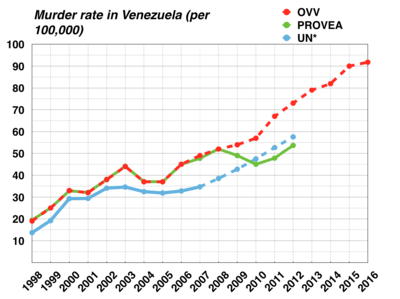
* UN dashed line is projected from missing data.
Venezuela's crime rate is a major cause of emigration.[1][26] According to sociologist Tomás Páez, Venezuelan parents and grandparents encourage young people to leave the country for their own good.[20]
Venezuela deteriorated under Hugo Chávez, with political instability and violence increasing.[45] According to Gareth A. Jones and Dennis Rodgers in their book, Youth violence in Latin America: Gangs and Juvenile Justice in Perspective, "With the change of political regime in 1999 and the initiation of the Bolivarian Revolution, a period of transformation and political conflict began, marked by a further increase in the number and rate of violent deaths".[46] The Bolivarian Revolution attempted to "destroy what previously existed, the status quo of society", with instability increasing as a result.[45] The government attributed violence and crime to poverty and inequality, boasting about reducing both as the Venezuelan murder rate increased.[45] The increase in the murder rate following the Chávez presidency has been attributed by experts to the corruption of Venezuelan authorities, poor gun control, and a poor judicial system.[47] The murder rate increased from 25 per 100,000 in 1999 (when Chávez was elected)[46] to 82 per 100,000 in 2014,[48] and kidnappings increased over twenty-fold from the beginning of the Chávez presidency to 2011.[49][50][51]
Economy
Since Hugo Chávez imposed stringent currency controls in 2003 in an attempt to prevent capital flight,[52] a series of currency devaluations has disrupted the Venezuelan economy.[53] Price controls and other government policies have caused severe shortages in Venezuela.[54] Venezuela's inflation rate passed 100 percent by 2015, the world's highest inflation rate and the highest in the country's history.[55] As a result of the shortages, Venezuelans must search for food (occasionally eating wild fruit or garbage), wait in line for hours, and live without some products.[56][57][58][59][60]
Many business owners have emigrated to countries with growing economies since the Bolivarian Revolution.[1] According to a 2018 Gallup analysis, "Government decisions have led to a domino-effect crisis that continues to worsen, leaving residents unable to afford basic necessities such as food and housing" and Venezuelans "believe they can find better lives elsewhere".[61]
Political repression

According to Venezuelan Community Abroad. A New Method of Exile, the Bolivarian government "would rather urge those who disagree with the revolution to leave, instead of pausing to think deeply about the damage this diaspora entails to the country".[1] Newsweek reported that Chávez "has pushed hard against anyone" who was not part of his movement, with science, business and media professionals emigrating from Venezuela.[2]
Up to 9,000 Venezuelan exiles lived in the United States in 2014, with the number of exiles also increasing in the European Union.[1] The Florida Center for Survivors of Torture reported in 2015 that most of those they assisted since the previous year were Venezuelan migrants, with the organization providing psychiatrists, social workers, interpreters, lawyers and doctors for dozens of individuals and their families.[62]
Effects
Education
Many Venezuelan emigrants are educated professionals.[20] Iván de la Vega of the Simón Bolívar University found that 60 to 80 percent of students in Venezuela said that they want to leave the country and not return to 2015 conditions.[63] Primary-and secondary-school students were also affected, with media reports of children at school fainting from hunger.[64] In Venezuela's border regions, the school dropout rate is as high as 80 percent.[65][66]
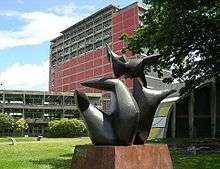
According to Iván de la Vega in a 2014 report, about a million Venezuelans had emigrated during the Chávez presidency but the number of academics was unknown;[67] the Central University of Venezuela lost more than 700 of its 4,000 professors between 2011 and 2015.[68] About 240 professors left Simón Bolívar University between 2009 and 2014,[67][68] with an additional 430 faculty members leaving from 2015 to 2017.[69]
Major reasons for the emigration of educational professionals are Venezuela's crime rate and low government pay.[67][68], According to Venezuelan Academy of Physical, Mathematical and Natural Sciences president Claudio Bifano, most of Venezuela's "technology and scientific capacity, built up over half a century" had been lost during Hugo Chávez's presidency. Despite two percent of the country's GDP invested in science and technology, the number of papers published in international journals fell from about 1,600 to 1,000 (the 1997 figure, when Venezuela's technology budget was 0.3 percent of GDP) from 2008 to 2012.[70]
Centre for Cultural Research and Education director Mariano Herrera estimated a shortage of about 40 percent of teachers for mathematics and science classes in 2014. The Venezuelan government attempted to ease the teacher shortage with the Simón Rodríguez Micromission, reducing the graduation requirement for educational professionals to two years.[71] From January to March 2018, 102 of 120 positions at Simón Bolívar University remained vacant.[72]
Venezuelan Community Abroad. A New Method of Exile, a 2014 study by Thomas Paez, Mercedes Vivas and Juan Rafael Pulido of the Central University of Venezuela, reported that over 90 percent of Venezuela's more than 1.5 million emigrants were college graduates; 40 percent had a master's degree, and 12 percent had doctorates or post-doctorate degrees.[20][21] The study used official data verified abroad and surveys from Venezuelans who had decided to emigrate.[20]
Economy
Businesspeople emigrated from Venezuela due to government price controls and corruption, shortages, and foreign exchange controls. Accountants and administrators left for countries experiencing economic growth, such as Argentina, Chile, Mexico, Peru, and the United States.[1] A Latin America Economic System study reported that the emigration of highly-skilled laborers age 25 or older from Venezuela to OECD countries rose by 216 percent between 1990 and 2007.[2]
An estimated 75 percent of about 20,000 PDVSA (Petróleos de Venezuela) workers who left the company emigrated to other countries for work.[22] Former oil engineers began work on oil rigs in the North Sea and in the tar sands of western Canada;[2] the number of Venezuelans in Alberta increased from 465 in 2001 to 3,860 in 2011.[73] Former PDVSA employees also joined the more-successful oil industry in neighboring Colombia.[73] According to El Universal, "thousands of oil engineers and technicians, adding up to hundreds of thousands of man-hours in training and expertise in the oil industry (more meaningful than academic degrees)" and most of PDVSA's former executive are working abroad.[1] After the PDVSA exodus, Venezuelan oil production decreased and work-related injuries increased.[73]
Media and the arts
Actors, producers, TV presenters, news anchors, and journalists have reportedly left for Colombia, Florida and Spain after the closing of media outlets by the Venezuelan government or their purchase by government sympathizers. Musicians emigrate to places receptive to their style of music.[1]
Medicine

Physicians and medical staff, particularly those in private facilities, emigrated due to low pay and lack of recognition following the Venezuelan government's opposition to traditional 6-year programs. The Bolivarian government instead supports Cuba's training of "community medical doctors". The government reportedly restricted access to facilities and funding for physician training, which led to medical programs closing throughout the country.[1]
Medical Federation of Venezuela president Douglas León Natera said in April 2015 that more than 13,000 doctors (over 50 percent of the country's total) had emigrated. According to Natera, the resulting physician shortage affected public and private hospitals alike.[74] In March 2018 (after 22,000 doctors had fled Venezuela), the salary of many physicians was less than US$10 per month.[75]
In Latin American countries, the medical credentials of Venezuelan doctors are generally accepted. Opportunities for Venezuelans are limited in the United States, however, with physicians often becoming medical assistants or working in non-medical fields.[75]
Statistics
According to Iván de la Vega, the number of Venezuelans living abroad increased by over 2,000 percent from the mid-1990s to 2013 (from 50,000 to 1,200,000).[76] The median emigrant age is 32.[63]
The percentage of Venezuelans who said that they had family abroad increased from 10 percent in 2004 to nearly 30 percent in 2014.[3] In 2014, about 10 percent said that they were preparing to emigrate.[3] According to the UN High Commissioner for Refugees, "Between 2003 and 2004, the number of (Venezuelan) refugees doubled from 598 to 1,256, and between 2004 and 2009, the number of Venezuelan refugees was five-fold higher, up to 6,221. By that date, there is also a log of 1,580 Venezuelan applicants for refuge."[27]
A late-2017 survey by Consultores 21 found that over four million Venezuelans had left the country due to the Bolivarian Revolution, and 51 percent of young adults said that they wanted to emigrate.[6] In 2018, it was estimated that over one million Venezuelans had plans to emigrate.[77] Emigrants primarily consist of professionals between 18 and 35. Most Venezuelans attempting to leave the country are in higher-income socioeconomic groups, although lower-income groups plan to emigrate as well.[3] Several minority populations have also declined significantly.
Colombian population
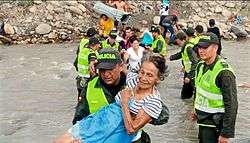
According to Universidad de los Andes sociologist Raquel Alvarez, 77 percent of immigrants to Venezuela during the 1990s were from Colombia. By the early 2010s, the Colombian immigrants were disappointed with Venezuela's economic collapse and discrimination by the government and its supporters. From tens of thousands to 200,000 Colombians left Venezuela in the years before 2015. The Colombian Ministry of Foreign Affairs reported that visas to Colombia increased by 150 percent between March 2014 and March 2015, and repatriation assistance of Colombian-Venezuelans reached a record number in the first quarter of 2015. Martin Gottwald, deputy head of the United Nations refugee agency in Colombia, said that many of the 205,000 Colombian refugees who had fled to Venezuela may return to Colombia. The number of repatriating Colombians concerned the Colombian government, due to its effect on unemployment and public services.[78]
Jewish population
The Jewish population in Venezuela has, according to several community organizations, declined from an estimated 18,000–22,000 in 2000[79] to about 9,000 in 2010.[80] Community leaders cite the economy, security, and increased antisemitism as major reasons for the decline. Some have accused the government of engaging in (or supporting) antisemitic action and rhetoric.[80][81][82][83][84][85][86] In 2015, it was reported that the Jewish population had declined to 7,000.[87]
Refugee life
Aid
Organizations and events have been created to assist Venezuelan emigrants. A website (MeQuieroIr.com), created by a former public-affairs employee of PDVSA who moved to Canada, quickly became popular among Venezuelan emigrants.[22][88][89] In June 2015, the first annual Migration Expo was held in Caracas; the event included support groups, study-abroad assistance and help with the emigration process.[90] The Somos Diáspora network, consisting of a website and radio station in Lima, Peru, was launched in May 2018 to provide Venezuelan entertainment, news and migration information to the diaspora.[91]
Problems
Crime
Mauro Medina, Peruvian Minister of the Interior[92]
The Maduro government often granted the emigration of Venezuelan criminals and organized crime into regional countries, with nations like Aruba, Colombia, Panama, Peru and the United States experiencing crimes as a result.[93][94] Many Venezuelan women in Colombia resort to prostitution to earn a living,[95] and some fight to the death with their Colombian counterparts.[96] In "La Chama", a Panamanian hit song by Mr. Saik, a Venezuelan woman resorts to prostitution; the singer received death threats from migrants.[97]
Criminals from Venezuela have also entered Peru.[93] In June 2018, a group of Venezuelans robbed a jewelry store in Jockey Plaza and fled the country. [98] On 27 July 2018, four Venezuelans shot and injured one police officer while robbing a store, though they were later captured.[99][100] The "Tren de Aragua" (Train of Aragua) gang of Venezuela–which flourished in their native country's impunity where they directed robbery, kidnapping and murder operations– saw five of their members arrested in August 2018 for planning a bank robbery at a shopping mall.[93][101][102] The Venezuelan gang members were found by the National Police of Peru equipped with firearms, a grenade and a map of the bank.[101] At least seventy-two Venezuelans were imprisoned in Peru by mid-2018.[93]
In Brazil, at least 1,200 Venezuelans were forced from refugee camps by residents of Pacaraima on 18 August 2018 after the family of a local merchant told the authorities that he had been assaulted by a group of Venezuelans. However, two days later the authorities said the assailants’ identity and nationality had not been confirmed.[103] The residents destroyed the migrant camps.[104][105][106]
Discrimination
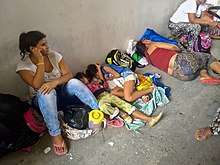
Venezuelan refugees have occasionally faced xenophobia and discrimination in destination countries.[107] The International Organization for Migration has increased awareness that refugees are vulnerable to trafficking and prostitution.[107] Venezuelans in Panama experience xenophobia due to competition with local residents, and Panamanian nationalist movements have used anti-Venezuelan-refugee rhetoric to gain support.[97]
Health
Infectious diseases
In 2018, polio re-emerged in Venezuela for the first time in decades. The re-emergence of polio, measles, and other communicable diseases as a result of Venezuela's physician shortage raised concerns in destination countries that refugees would spread disease throughout the region. Measles outbreaks occurred in Brazil, Colombia, and Ecuador in areas in which Venezuelan refugees lived; most of the infected were refugees.[108] Increases in malaria and diphtheria in Venezuela have also raised concerns in neighboring countries.[64]
Mental health
Many Venezuelan refugees suffer from posttraumatic stress disorder due to the traumatic events they have experienced within their native country.[109] Migrants experience both physical and psychological symptoms from their traumas which are caused by violence in Venezuela, leaving relatives behind and adapting to the culture of their host countries.[109]
Destinations
The top ten destinations for Venezuelan emigrants are Colombia, Peru, the United States, Spain, Italy, Portugal, Argentina, Canada, France, and Panama.[110] Tens of thousands of Venezuelans have also moved to other locations, including Trinidad and Tobago[111] and other countries in the Americas and Europe.[20][112]
Venezuelans have fled to over 90 countries in pursuit of a better life.[5] Between 2015 and 2017, Venezuelan immigration increased by 1,388 percent in Chile, 1,132 percent in Colombia, 1,016 percent in Peru, 922 percent in Brazil, 344 percent in Argentina and Ecuador, 268 percent in Panama, 225 percent in Uruguay, 104 percent in Mexico, 38 percent in Costa Rica, 26 percent in Spain, and 14 percent in the United States.[16]
United States
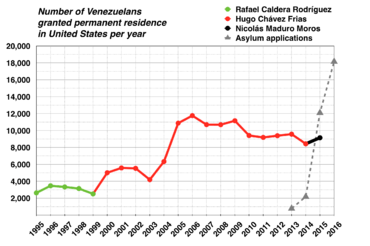
The United States is one of the main destinations for Venezuelan emigrants.[4][20][27] The number of U.S. residents who identified as Venezuelan increased by 135 percent between 2000 and 2010, from 91,507 to 215,023.[116] In 2015, it was estimated that about 260,000 Venezuelans had emigrated to the United States.[63] According to researcher Carlos Subero, "The vast majority of Venezuelans trying to migrate enter the country with a non-immigrant tourist or business visa"; 527,907 Venezuelans remain in the United States with non-immigrant visas.[3] The Latin American and Caribbean Economic System (SELA) reported that in 2007, 14 percent of Venezuelans 25 and older in the United States had a Ph.D. (more than the U.S. average of nine percent).[27]
The largest community of Venezuelans in the United States lives in South Florida.[20] Between 2000 and 2012, the number of legal Venezuelan residents in Florida increased from 91,500 to 259,000.[117] In 2015, the Venezuelan Refugee Assistance Act was proposed by four Florida delegates to the United States House of Representatives.[117] The act would adjust the status of Venezuelans without a criminal record or involvement in persecution who arrived in the United States before 1 January 2013, with a deadline of 1 January 2019 to apply for adjustment.[117] One chief sponsor, U.S. Representative Carlos Curbelo, said: "This bill will help those Venezuelan nationals who have made a new home in the United States to remain here if they choose to, since it is dangerous to return home".[117] The bill was sent to the House Judiciary Committee.[117]
Latin America and the Caribbean
Latin American countries, such as Argentina, Brazil, Chile, Colombia, Mexico, Peru and Panama, are popular destinations for Venezuelan emigrants.[36]
Argentina
.jpg)
Venezuelan immigration has increased significantly since 2005, from 148 annually to 12,859 in 2016. Over 15,000 Venezuelans emigrated to Argentina from 2004 to 2014, of whom 4,781 have obtained permanent residency.[118][110] The number of Venezuelan immigrants increased by 500 percent from 2014 to 2016, to 600 per week. Between 2014 and mid-2017, 38,540 Venezuelans filed residency applications in Argentina.[110][119]
Venezuelans emigrating to Argentina face several obstacles (such as the cost of plane fare), due to the distance between the countries compared with neighboring Colombia and Brazil. Attracted by better living conditions, many risk the trip by land; Marjorie Campos, a Venezuelan woman who was eight months pregnant, traveled by bus for 11 days across Colombia, Ecuador, Peru and Chile to reach the Argentine city of Cordoba.[120]
Brazil
Col. Edvaldo Amara, Roraima civil-defense chief[31]
As socioeconomic conditions worsened, many Venezuelans emigrated to neighboring Brazil. Tens of thousands of refugees traveled through the Amazon basin seeking a better life, some traveling by foot and paying over $1,000 to be smuggled into larger cities. The Brazilian government increased its military presence on the border to assist refugees on its roads and rivers.[31] Over 70,000 refugees[121] entered the Brazilian state of Roraima in late 2016, straining local resources.[19] Hundreds of Venezuelan children are enrolled in schools near the Brazil-Venezuela border, and about 800 Venezuelans entered Brazil daily by 2018.[122]
Caribbean islands
Once a tourist and vacation destination for Venezuelans, the islands of Aruba and Curaçao require Venezuelan refugees to have at least $1,000 in cash before entering (over five years' income for a Venezuelan working a minimum-wage job). Patrols and deportation of Venezuelans has increased, and Aruba has dedicated a stadium to hold up to 500 Venezuelan migrants facing deportation.[31]
The journey to Curaçao is an often-dangerous 60-mile (97 km) trip, with "backbreaking swells, gangs of armed boatmen and coast-guard vessels looking to capture migrants and send them home".[31] Venezuelans are brought near the island's shore, dumped overboard and forced to swim to land, where they meet contacts to set up their new lives. According to Curaçao uthorities, common jobs held by Venezuelans on the islands serve tourists; immigrants "clean the floors of restaurants, sell trinkets on the street, or even solicit Dutch tourists for sex, forced by the smugglers to pay for their passage by working in a brothel".[31] The Dutch Caribbean Coast Guard estimates that only five to ten percent of boats carrying Venezuelan migrants are intercepted.[31]
Venezuelans have historically emigrated (legally and illegally) to Trinidad and Tobago, due to the country's relatively-stable economy, access to United States dollars, and close proximity to eastern Venezuela.[123] Direct flights from Maturin, Caracas and Isla Margarita and ferry service between Guiria and Chaguaramas, Trinidad and Tucupita and Cedros, Trinidad and Tobago are legal transport routes; illegal routes exist between Venezuela's east coast and the Gulf of Paria.[124] About 14,000 Venezuelans entered Trinidad and Tobago between 1 January and 10 May 2016, with 43 percent reportedly overstaying their visas.[123] Venezuelans who remain often seek employment on the island; others, particularly women, enter the sex industry.[125]
Colombia
Following the reopening of the Colombian border after the Venezuela–Colombia migrant crisis, many Venezuelans emigrated there.[126] In July 2016, over 200,000 Venezuelans entered Colombia to purchase goods due to shortages in Venezuela.[127] On 12 August 2016, the Venezuelan government reopened the border; thousands of Venezuelans again entered Colombia to escape the Venezuelan crisis.[127] Colombia's oil industry has benefited from skilled Venezuelan immigrants, although the country began deporting unauthorized immigrants in late 2016.[126]
According to the Colombian government, more than 100,000 Venezuelans emigrated to Colombia in the first half of 2017.[40] In the run-up to the 2017 Venezuelan Constituent Assembly elections, Colombia granted a Special Permit of Permanence to Venezuelan citizens who entered the country before 25 July; over 22,000 Venezuelans applied for permanent residence in the permit's first 24 hours of existence.[41] By the end of November 2017, over 660,000 Venezuelans were in Colombia (over double the number in June).[42]
By the end of August 2017, near 1 million Venezuelans were in Colombia.[128]
Chile
Between 2015 and 2017, Venezuelan emigration to Chile increased by 1,388 percent.[16] In 2016, Venezuelans emigrated to Chile due to its stable economy and simple immigration policy. According to the Chilean Department for Foreigners and Migration, the number of Chilean visas for Venezuelans increased from 758 in 2011 to 8,381 in 2016; 90 percent were work visas for Venezuelans aged 20 to 35. Since international travel by air is difficult (especially due to the value of the Venezuelan bolívar), many Venezuelans must travel overland through dangerous terrain to reach Chile. After arriving, they must start a new life. According to Catholic Chilean Migration Institute executive secretary Delio Cubides, most Venezuelan immigrants "are accountants, engineers, teachers, the majority of them very well-educated" but accept low-paying jobs so they can meet visa requirements and remain in the country.[126][129]
Mexico
The Venezuelan Mexican population increased from 2,823 in 2000 to 10,063 in 2010, a 357-percent increase in Venezuelan-born people living in Mexico.[130] Mexico granted 975 Venezuelans permanent identification cards in the first five months of 2014, double the number of ID cards issued in 2013.[36]
Peru
Peruvian President Pedro Pablo Kuczynski introduced legislation granting Venezuelan nationals in Peru a Temporary Permit of Permanence (PTP). The Inter-American Commission on Human Rights approved, encouraging other Latin American countries to adopt similar measures. The Venezuelan Union in Peru, a non-governmental organization, announced that they would present President Kuczynski's actions to the Norwegian Nobel Committee and nominate him for the Nobel Peace Prize:[132]
[W]hile other countries build walls, in Peru, bridges are built to bring citizens closer and protect their most elementary fundamental rights, so with overwhelming hope we will present this nomination of President Pedro Pablo Kuczynski, not only in search of this award, but also to place in the international debate the abuses of which Latin American migrants are victims in some parts of the world.
In August 2017, a little over three months after the decree, over 40,000 Venezuelan refugees had entered Peru.[133] By mid-2018 [134], over 400,000 Venezuelans had emigrated to Peru.[135] In a United Nations survey, 61.9 percent of Venezuelans who moved to Peru worked in retail, tourism or a similar position; 9.4 percent worked in industry and construction.[136] Forty-six percent earned between 984 and 1,968 soles ($300–600) per month; 34 percent earned between 656 and 984 soles ($200–300), and 11 percent earned less than 656 soles per month (less than $200).[136]
Response
International
Intergovernmental organizations

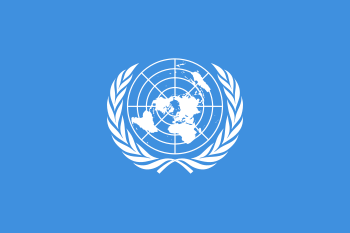
Governments



Catholic Church
The Catholic Church in Peru organized programs to help Venezuelan refugees, dedicating masses and collections to the migrants.[144]
Domestic
President Nicolás Maduro said that international reports of millions of Venezuelans emigrating are "propaganda", and Venezuelans regret leaving the country because they end up "cleaning toilets in Miami".[77] Angry Venezuelans criticized Maduro, saying that they would rather clean toilets in another country than live in Venezuela.[77]
See also
References
- 1 2 3 4 5 6 7 8 9 10 11 12 Olivares, Francisco (13 September 2014). "Best and brightest for export". El Universal. Retrieved 24 September 2014.
The Bolivarian diaspora is a reversal of fortune on a massive scale
- 1 2 3 4 5 6 7 8 "Hugo Chavez is Scaring Away Talent". Newsweek. 30 June 2009. Retrieved 24 September 2014.
The Bolivarian diaspora is a reversal of fortune on a massive scale
- 1 2 3 4 5 "Ten percent of Venezuelans are taking steps for emigrating". El Universal. 16 August 2014. Retrieved 26 April 2015.
- 1 2 3 "La emigración venezolana a diferencia de otras "se va con un diploma bajo el brazo"". El Impulso. 17 December 2014. Retrieved 21 December 2014.
- 1 2 Leon, Adriana (19 October 2017). "Driven by unrest and violence, Venezuelans are fleeing their country by the thousands". Los Angeles Times. Retrieved 19 October 2017.
- 1 2 3 "Gracias a las malas políticas del Gobierno bolivariano, más de 4 millones de venezolanos se han ido del país (encuesta)". La Patilla (in Spanish). 19 January 2018. Retrieved 20 January 2018.
- ↑ Board, Editorial (23 February 2018). "Opinion | Latin-America's worst-ever refugee crisis: Venezuelans". The Washington Post. Retrieved 25 February 2018.
This human outflow, ... is the largest displacement of people in Latin American history
- ↑ Hylton, Wil S. (2018-03-09). "Leopoldo López Speaks Out, and Venezuela's Government Cracks Down". The New York Times. ISSN 0362-4331. Retrieved 2018-03-12.
Venezuela is the most urgent humanitarian disaster in the Western Hemisphere, producing the largest exodus of refugees in the history of the Americas
- ↑ "Venezuela's mounting refugee crisis". Financial Times. 2018-04-20. Retrieved 2018-04-22.
- ↑ "Venezuela's exodus: Forced to flee". Al Jazeera. 15 September 2018. Retrieved 2018-09-15.
Latin America is facing the largest refugee crisis in its history as hundreds of thousands of people flee Venezuela to escape severe economic hardship.
- ↑ • Maria Delgado, Antonio (28 August 2014). "Venezuela agobiada por la fuga masiva de cerebros". El Nuevo Herald. Retrieved 28 August 2014.
The massive emigration of Venezuelans, a trend that was unprecedented in the republican history of the nation, is mainly motivated by personal insecurity, legal insecurity and lack of options to progress under the Bolivarian regime
- Weddle, Cody (18 March 2017). "More desperate college grads flee Venezuela". WPLG. Retrieved 15 October 2017.
some academics refer to the exodus in its totality as the Bolivarian diaspora
- Wyss, Jim (25 July 2017). "As Venezuela faces critical week, Colombia prepares for a wave of migrants". The Miami Herald. Retrieved 15 October 2017.
And as conditions in Venezuela worsen, the “Bolivarian Diaspora” is likely to keep growing. One measure of the desperation:the number of Venezuelans seeking asylum abroad tripled from 2015 to 2016.
- Manner, Benedict (5 September 2017). "A family bereavement brings home Venezuela's crisis". Financial Times. Retrieved 15 October 2017.
Like the rest of the 'Bolivarian diaspora' dotted around the globe, it has been impossible to escape the asphyxiating drama
- Weddle, Cody (18 March 2017). "More desperate college grads flee Venezuela". WPLG. Retrieved 15 October 2017.
- ↑ Cannon, Barry (2013). Hugo Chávez and the Bolivarian Revolution: Populism and Democracy in a Globalised Age. Manchester University Press. ISBN 1847797199.
- ↑ Canelón-Silva, Agrivalca Ramsenia (2014). "Del Estado Comunicador Al Estado De Los Medios. Catorce Años De Hegemonía Comunicacional En Venezuela". Palabra Clave. University of La Sabana. 17 (4): 1243–78.
- ↑ Rory, Carroll, (2014). Comandante : Hugo Chavez's Venezuela. Penguin Books: New York. pp. 182–94. ISBN 0143124889.
- ↑ 남민우, 기 (2 May 2018). "화폐경제 무너졌는데…최저임금 인상에 목매는 베네수엘라". 朝鮮日報 (in Korean). Retrieved 22 May 2018.
Venezuela's fall is considered to be mainly caused by the populist policy ... Venezuela, for decades, has increased the number of public sector employees and has promoted populist support to maintain the regime
- 1 2 3 "'I can't go back': Venezuelans are fleeing their crisis-torn country en masse". Washington Post. Retrieved 2018-04-07.
- 1 2 Welsh, Teresa (19 September 2018). "Venezuela crisis is 'on the scale of Syria,' UNHCR says". Devex. Retrieved 21 September 2018.
- ↑ "Venezuela government denies facing migration crisis". Al Jazeera. 4 September 2018. Retrieved 2018-09-04.
- 1 2 LaFranchi, Howard (2 November 2016). "Why time is ripe for US to address Venezuela's mess". Christian Science Monitor. Retrieved 4 November 2016.
- 1 2 3 4 5 6 7 8 9 10 Maria Delgado, Antonio (28 August 2014). "Venezuela agobiada por la fuga masiva de cerebros". El Nuevo Herald. Retrieved 28 August 2014.
The massive emigration of Venezuelans, a trend that was unprecedented in the republican history of the nation, is mainly motivated by personal insecurity, legal insecurity and lack of options to progress under the Bolivarian regime
- 1 2 3 "El 90% de los venezolanos que se van tienen formación universitaria". El Impulso. 23 August 2014. Retrieved 28 August 2014.
- 1 2 3 Pitts, Pietro D.; Rosati, Andrew (4 December 2014). "Venezuela's Oil Industry Exodus Slowing Crude Production: Energy". Bloomberg. Retrieved 24 January 2015.
- ↑ Lee, Brianna (2 December 2015). "Venezuela Elections 2015: Why Venezuelans Are Fleeing The Country". International Business Times. Retrieved 30 December 2015.
- ↑ Margolis, Mac (14 September 2016). "Latin America Has a Different Migration Problem". Bloomberg. Retrieved 22 September 2016.
- ↑ Forero, Juan; Protti, Tommaso (13 February 2018). "Venezuela's Misery Fuels Migration on Epic Scale". Wall Street Journal. Retrieved 13 February 2018.
- 1 2 3 Gonzalez, Angel; Minaya, Ezequiel (17 October 2011). "Venezuelan Diaspora Booms Under Chávez". Dow Jones & Company Inc. The Wall Street Journal. Retrieved 8 October 2014.
- 1 2 3 4 Pablo Peńaloza, Pedro (13 January 2014). "Number of outgoing Venezuelans on the rise". El Universal. Retrieved 26 April 2015.
- ↑ Casey, Nicholas (5 January 2016). "Arriving in Venezuela and Taking a Selfie, as Many of My Peers Depart". The New York Times. Retrieved 14 January 2016.
- ↑ "Régimen se burla de la diáspora colocando réplica de Obra de Cruz Diez para "selfies"". Venezuela al Día (in Spanish). 9 January 2018. Retrieved 15 February 2018.
- ↑ Brown, Tom (16 July 2007). "Venezuelans, fleeing Chavez, seek U.S. safety net". Reuters. Retrieved 22 September 2014.
- 1 2 3 4 5 6 7 8 9 10 11 Casey, Nicholas (25 November 2016). "Hungry Venezuelans Flee in Boats to Escape Economic Collapse". The New York Times. Retrieved 27 November 2016.
- 1 2 "Dateline migration: International". Migration World Magazine. 30 (4/5): 7–13. 2002.
- ↑ "AREPA 14" (PDF). United States Department of State. Retrieved 4 February 2015.
- ↑ "La historia de una familia que abandonó Venezuela". Noticias24. 18 March 2007. Retrieved 16 October 2014.
- 1 2 "Diego Beltrand: Más de 1 millón 642 mil venezolanos migraron en 2017 (Video)". La Patilla (in Spanish). 30 April 2018. Archived from the original on 1 May 2018. Retrieved 1 May 2018.
- 1 2 3 Symmes Cobb, Julia; Garcia Rawlins, Carlos (15 October 2014). "Economic crisis, political strife drive Venezuela brain-drain". Reuters. Retrieved 15 October 2014.
- ↑ "Venezuela's Health Crisis: 40 Percent of New Medical Graduates Have Already Left". PanAm Post. 12 December 2017. Retrieved 13 December 2017.
- ↑ "1,8 millones de venezolanos han emigrado en 10 años". Globovision. 23 April 2015. Retrieved 26 April 2015.
- ↑ "PGA Group estima que 1,8 millones de venezolanos han emigrado en 10 años". La Nación. 23 April 2015. Retrieved 26 April 2015.
- 1 2 "As Venezuela's economy plummets, mass exodus ensues". PBS NewsHour. 9 July 2017. Retrieved 10 July 2017.
- 1 2 "Unos 22 mil venezolanos tramitaron en 24 horas permiso especial en Colombia". La Patilla (in Spanish). 4 August 2017. Retrieved 4 August 2017.
- 1 2 "Venezuela Situation Update, November 2017". ReliefWeb. UN High Commissioner for Refugees. Retrieved 26 December 2017.
- ↑ Wyss, Jim (2018-06-13). "Almost 1 million people moved from Venezuela to Colombia in just two years, study shows". The Miami Herald. Retrieved 2018-06-15.
According to the International Organization on Migration, there were at least 1.6 million Venezuelans living abroad in 2017 — up from 698,000 in 2015. But Wednesday’s data, and studies in Venezuelan universities and elsewhere, suggest the total number could be much higher.
- ↑ Cohen, Luc. "Venezuelans buy bus tickets out after Maduro wins re-election". Reuters. Retrieved 2018-05-23.
- 1 2 3 Briceño-León, Roberto. "Three phases of homicidal violence in Venezuela". SciELO. Retrieved 8 July 2015.
- 1 2 Jones, Gareth A.; Rodgers, Dennis, eds. (2008). Youth violence in Latin America : gangs and juvenile justice in perspective (1st ed.). Basingstoke: Palgrave Macmillan. pp. 84–85. ISBN 978-0-230-60056-0. Retrieved 1 October 2014.
- ↑ Rueda, Manuel (6 April 2015). "Venezuelan beauty queen gets carjacked at gunpoint". Fusion. Retrieved 9 April 2015.
- ↑ "Venezuela Ranks World's Second In Homicides: Report". NBC News. 29 December 2014. Retrieved 3 January 2015.
- ↑ "SeguridadPúblicayPrivada VenezuelayBolivia" (PDF). Oas.org. Retrieved 2015-03-30.
- ↑ "Venezuela: Gravísima Crisis de Seguridad Pública by Lexys Rendon". ISSUU.com. Retrieved 2015-03-30.
- ↑ "Según el Cicpc el 2011 cerró con 1.150 secuestros en todo el país – Sucesos". Eluniversal.com. Retrieved 2015-03-30.
- ↑ "Venezuela's currency: The not-so-strong bolívar". The Economist. 11 February 2013. Retrieved 18 February 2013.
- ↑ Mander, Benedict (10 February 2013). "Venezuelan devaluation sparks panic". Financial Times. Retrieved 11 February 2013.
- ↑ "Venezuela's economy: Medieval policies". The Economist. 20 August 2011. Retrieved 23 February 2014.
- ↑ Cristóbal Nagel, Juan (13 July 2015). "Looking Into the Black Box of Venezuela's Economy". Foreign Policy. Retrieved 14 July 2015.
- ↑ "Why are Venezuelans posting pictures of empty shelves?". BBC. 8 January 2015. Retrieved 10 January 2015.
- ↑ Cawthorne, Andrew (21 January 2015). "In shortages-hit Venezuela, lining up becomes a profession". Reuters. Retrieved 17 June 2015.
- ↑ MacDonald, Elizabeth (26 May 2016). "Exclusive: Harrowing Video Shows Starving Venezuelans Eating Garbage, Looting". Fox Business. Retrieved 12 July 2016.
- ↑ Sanchez, Fabiola (8 June 2016). "As hunger mounts, Venezuelans turn to trash for food". Associated Press. Retrieved 12 July 2016.
- ↑ "Mangoes fill the gaps in Venezuela's food crisis". Canadian Broadcasting Corporation. 7 June 2016. Retrieved 12 July 2016.
- ↑ "Four in 10 Venezuelans Would Leave Venezuela Behind". Gallup Inc. 6 March 2018. Retrieved 13 March 2018.
- ↑ Fernández, Abel (16 July 2015). "New victims of oppression seeking help at Miami center come from Venezuela". Miami Herald. Archived from the original on 25 July 2015. Retrieved 17 August 2018.
- 1 2 3 Zabludovsky, Karla (15 May 2015). "Venezuela's Lost Generation". BuzzFeed. Retrieved 3 June 2015.
- 1 2 Johnson, Keith (16 July 2018). "How Hugo Chávez Blew Up Venezuela's Oil Patch". Foreign Policy. Retrieved 21 July 2018.
- ↑ "Deserción escolar se ubica en 58% en todo el país". La Patilla (in Spanish). 2018-07-17. Retrieved 2018-07-18.
- ↑ "Deserción escolar alcanza el 58% en todo el país". Contexto Diario (in Spanish). Retrieved 2018-07-18.
- 1 2 3 Small Carmona, Andrea. "Poor conditions blamed for Venezuelan scientist exodus". SciDev. Retrieved 9 July 2014.
- 1 2 3 Rueda, Jorge (11 June 2015). "Professors Flee, Higher Education Suffers in Venezuela". Associated Press. Retrieved 16 June 2015.
- ↑ Gillespie, Patrick (30 November 2017). "Amid mass exodus, Venezuela is losing its teachers". CNN. Archived from the original on 30 November 2017. Retrieved 17 August 2018.
- ↑ "Capacity building: Architects of South American science" (PDF). Nature. 510: 212. 12 June 2014. doi:10.1038/510209a. Retrieved 9 July 2014.
- ↑ Montilla K., Andrea (4 July 2014). "Liceístas pasan de grado sin cursar varias materias". El Nacional. Retrieved 9 July 2014.
- ↑ ""Los profesores están abandonando la Universidad Simón Bolívar"". La Patilla (in Spanish). 2018-06-06. Retrieved 2018-06-07.
- 1 2 3 "Venezuela's oil diaspora Brain haemorrhage". The Economist. 19 July 2014. Retrieved 5 August 2015.
- ↑ "León Natera: Más de 13 mil médicos se han ido del país". El Nacional. 7 April 2015. Retrieved 8 April 2015.
- 1 2 Maria Delgado, Antonio (28 March 2018). "Los médicos se unen al éxodo, más de 22,000 ya han huido de Venezuela". El Nuevo Herald. Retrieved 29 March 2018.
- ↑ Vásquez, Elisa (27 June 2014). "Venezuela's Emigration Wave Takes Toll on Mental Health". PanAm Post. Retrieved 12 May 2015.
- 1 2 3 4 Krygier, Rachelle (2018-04-04). "Angry Venezuelans tell Maduro they'd rather clean America's toilets than stay in their country". Washington Post. ISSN 0190-8286. Retrieved 2018-04-05.
- ↑ Kurmanaev, Anatoly; Medina, Oscar (4 May 2015). "Venezuela's Poor Neighbors Flee en Masse Years After Arrival". Bloomberg Business. Retrieved 10 May 2015.
- ↑ Shlomo Papirblat (November 20, 2010). "In Venezuela, remarks like 'Hitler didn't finish the job' are routine". Ha'aretz. Retrieved November 20, 2010. See also Gil Shefler (September 1, 2010). "Jewish community in Venezuela shrinks by half". The Jerusalem Post. Retrieved November 20, 2010.
- 1 2 Rueda, Jorge (4 December 2007). "Jewish leaders condemn police raid on community center in Venezuela". U-T San Diego. Retrieved 8 April 2015.
- ↑ Hal Weitzman (March 26, 2007). "Venezuelan Jews fear for future". JTA. Archived from the original on November 24, 2007. Retrieved April 3, 2008.
- ↑ Thor Halvorssen Mendoza (August 8, 2005). "Hurricane Hugo". The Weekly Standard. 10 (44). Retrieved November 20, 2010.
- ↑ Annual Report 2004: Venezuela. Archived October 23, 2006, at the Wayback Machine. Stephen Roth Institute. Accessed August 11, 2006.
- ↑ Berrios, Jerry. S. Fla. Venezuelans: Chavez incites anti-Semitism. Archived 2008-03-06 at the Wayback Machine. Miami Herald, August 10, 2006.
- ↑ Report: Anti-Semitism on Rise in Venezuela; Chavez Government 'Fosters Hate' Toward Jews and Israel. Press release, Anti-Defamation League, November 6, 2006. Accessed April 3, 2008.
- ↑ The Chavez Regime: Fostering Anti-Semitism and Supporting Radical Islam. Anti-Defamation League, November 6, 2006. Accessed April 3, 2008.
- ↑ "ADL Denounces Anti-Semitic Graffiti Sprayed on Synagogue in Venezuela". Algemeiner Journal. 2 January 2015. Retrieved 4 January 2015.
- ↑ "¿Quiénes somos?". MeQuieroIr.com. Retrieved 15 October 2014.
- ↑ "Weg!". De Redactie. 5 January 2015.
- ↑ Rosati, Andrew (16 June 2015). "Venezuela: Emigration Nation". WLRN-FM. Retrieved 2 August 2015.
- ↑ "Diáspora venezolana en el mundo ahora cuenta con su propia radio". La Patilla (in Spanish). 3 June 2018. Retrieved 4 June 2018.
- ↑ "Mauro Medina: "Venezolanos de mal vivir se cuelan por la frontera"". Peru21 (in Spanish). 2018-08-05. Retrieved 2018-08-19.
- 1 2 3 4 "Un colador: Maduro facilita emigración de criminales venezolanos". PanAm Post (in Spanish). 2018-08-06. Retrieved 2018-08-18.
- ↑ "Captura de megabanda de Venezuela en Perú es mala señal para la región". Insight Crime (in Spanish). 2018-08-10. Retrieved 2018-08-19.
- ↑ "Venezuelans sell sex in Colombia to survive". The Economist. 20 July 2017. Retrieved 2018-05-03.
- ↑ "Prostitution Rises in Countries Bordering Venezuela as Crisis Drives People Out". PanAm Post. 2017-01-24. Retrieved 2018-05-03.
- 1 2 "Venezuelans, Go Home: Xenophobia Haunts Refugees". Bloomberg. 2018-03-05. Retrieved 2018-05-03.
- ↑ "Asalto al Jockey Plaza: líder de la banda fugó del país". La Republica (in Spanish). 2018-07-04. Retrieved 2018-08-18.
- ↑ "Tiroteo en Jockey Plaza: destacan valentía de policías heridos". La Republica (in Spanish). 2018-06-22. Retrieved 2018-08-19.
- ↑ "SMP: capturan a venezolanos que balearon a un policía". La Republica (in Spanish). 2018-07-29. Retrieved 2018-08-19.
- 1 2 "Ordenan prisión preventiva a banda del "Tren de Aragua" capturada en Perú". El Universal (in Spanish). 2018-08-13. Retrieved 2018-08-18.
- ↑ "Detienen cinco venezolanos que intentaban robar un banco en Lima, Perú". El Universal (in Spanish). 2018-05-08. Retrieved 2018-08-18.
- ↑ Andreoni, Manuela (19 August 2018). "Residents of Brazil Border Town Attack Camps for Venezuelan Migrants". The New York Times. Retrieved 23 August 2018.
- ↑ Villamar, Inacio Doce. "Tense calm on Brazil-Venezuelan border after anti-immigrant riot". Reuters. Retrieved 2018-08-19.
- ↑ "Corren a venezolanos en la frontera con Brasil por la muerte de un comerciante". La Patilla (in Spanish). 2018-08-18. Retrieved 2018-08-18.
- ↑ "Brasileños expulsaron a venezolanos de refugio en Paracaima". El Nacional (in Spanish). 2018-08-18. Retrieved 2018-08-18.
- 1 2 Seminario, Francisco (2 May 2018). "La Organización Internacional para las Migraciones advirtió que los venezolanos pueden ser víctimas de discriminación, trata y prostitución forzada". Infobae (in Spanish). Retrieved 2018-05-03.
- ↑ "Polio returns to Venezuela, and threatens the region". The Economist. 2018-06-14. Retrieved 2018-06-15.
- 1 2 "Migrantes venezolanos llegan con estrés postraumático a su país de destino". La Patilla (in Spanish). 2018-10-03. Retrieved 2018-10-04.
- 1 2 3 "Masivo éxodo de venezolanos hacia Argentina: en dos años se quintuplicaron las solicitudes de residencia". Infobae. 17 July 2017.
- ↑ http://www.trinidadexpress.com/20160512/news/14000-venezuelans-flock-to-tt
- ↑ "Cada vez más venezolanos quieren vivir en Colombia". La Patilla (in Spanish). 8 October 2015. Retrieved 11 June 2016.
- ↑ "2004 Yearbook of Immigration Statistics" (PDF). United States Department of Homeland Security. Retrieved 8 October 2014.
- ↑ "2009 Yearbook of Immigration Statistics" (PDF). United States Department of Homeland Security. Retrieved 8 October 2014.
- ↑ "Yearbook of Immigration Statistics: 2013". United States Department of Homeland Security. Retrieved 8 October 2014.
- ↑ "The Hispanic Population: 2010, 2010 Census Briefs" (PDF). United States Census Bureau. May 2011. Retrieved 20 May 2015.
- 1 2 3 4 5 Durby, Kevin (12 October 2015). "Florida Congressional Representatives Want to Extend Venezuelans Exiles Stays". Sunshine State News. Retrieved 13 October 2015.
- ↑ "Argentina se vuelve destino clave para la emigración venezolana". El Universal. 16 March 2015.
- ↑ "Cada semana 600 venezolanos emigran a Argentina en busca de oportunidades". Su Noticiero. 2 November 2017.
- ↑ "Embarazada de 8 meses viajó 11 dias en colectivo para tener a su bebé en Argentina". Clarín. 16 August 2017.
- ↑ "Maduro fecha fronteira com Brasil e Colômbia até 2017". globo.com (in Portuguese). Archived from the original on 19 December 2016. Retrieved 17 August 2018.
- ↑ "Ochocientos venezolanos huyen a Brasil cada día revela la Agencia ONU para Refugiados". La Patilla (in Spanish). Retrieved 2018-04-07.
- 1 2 Rhondor Dowlat (10 May 2016). "Venezuelans cautious entering Cedros, Icacos". Trinidad & Tobago Guardian. Retrieved 17 August 2018.
- ↑ Rhonda Krystal Rambally (22 May 2016). "Venezuelans flock to T&T for supplies". Trinidad & Tobago Guardian. Retrieved 17 August 2018.
- ↑ Radhica Sookraj (5 June 2016). "Venezuelans taking T&T jobs". Trinidad and Tobago Guardian. Retrieved 17 August 2018.
- 1 2 3 Woody, Christopher (2 December 2016). "'The tipping point': More and more Venezuelans are uprooting their lives to escape their country's crises". Business Insider. Retrieved 6 December 2016.
- 1 2 "Venezuelans cross into Colombia after border is reopened". BBC News. 13 August 2016. Retrieved 30 November 2016.
- ↑ http://migracioncolombia.gov.co/index.php/es/prensa/infografias/8276-colombia-y-venezuela-mas-que-2-200-kilometros-de-frontera
- ↑ Fernández, Airam (12 October 2016). "Venezuelans flee to Chile in risky nine-day journey by road and river". Univision. Retrieved 6 December 2016.
- 1 2 "Estadísticas Históricas de México" (PDF). National Institute of Statistics and Geography. pp. 83, 86. Archived from the original (PDF) on 1 February 2016. Retrieved 2 June 2015.
- ↑ "Censo de Población y Vivienda 2010" (PDF). National Institute of Statistics and Geography. Retrieved 3 June 2015.
- ↑ "Venezolanos en Perú postularán a presidente Kuczynski a Nobel de la Paz". La Patilla (in Spanish). 16 April 2017. Retrieved 18 April 2017.
- ↑ "Peru fears Venezuela headed toward civil war: foreign minister". Reuters. 10 August 2017. Retrieved 10 August 2017.
- ↑ "Migraciones: entre 400 a 500 venezolanos salen a diario de Peru". El Comercio. 24 August 2018. Retrieved 24 August 2018.
- ↑ "Eurodiputados piden ayuda de emergencia por crisis migratoria en Venezuela". La Patilla (in Spanish). 3 July 2018. Retrieved 4 July 2018.
- 1 2 "Más de 60% de los venezolanos en Lima labora en el sector comercial - LaPatilla.com". La Patilla (in Spanish). 2018-07-11. Retrieved 2018-07-12.
- ↑ "Unión Europea busca ayudar a Colombia para atender masiva migración venezolana". La Patilla (in Spanish). 2018-04-05. Retrieved 2018-04-05.
- 1 2 "WFP Level 2 Emergency: Colombia-Venezuela Crisis, 6 April 2018". ReliefWeb. Retrieved 2018-04-08.
- ↑ "Venezuela migrant crisis 'monumental': UN Refugee Agency chief". Retrieved 2018-10-08.
- ↑ "Noruega destinará un millón de dólares a venezolanos vulnerables". El Nacional (in Spanish). 2018-04-09. Retrieved 2018-04-10.
- ↑ Ordoñez, Franco (20 March 2018). "US to give $2.5M to assist with Venezuelan refugees stranded across border". The News & Observer. Retrieved 22 March 2018.
- ↑ Greenwood, Max (13 April 2018). "Pence announces $16M in aid for refugees fleeing Venezuela". TheHill. Retrieved 14 April 2018.
- ↑ Babb, Carla (17 August 2018). "US Navy Hospital Ship to Deploy to Colombia". Voice of America. Retrieved 2018-08-19.
- ↑ "Church in Peru launches collection to help Venezuelan refugees". Catholic News Agency. Retrieved 2018-05-25.
External links
- Somos Diáspora – Network with Venezuelan entertainment, news and migration information
- Watson, Katy. "The bridge of desperation". BBC. Retrieved August 25, 2018.
